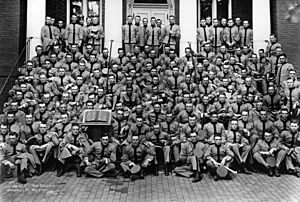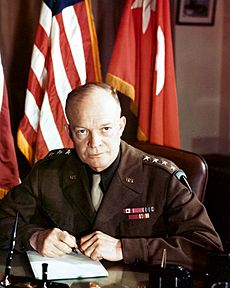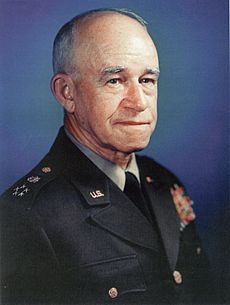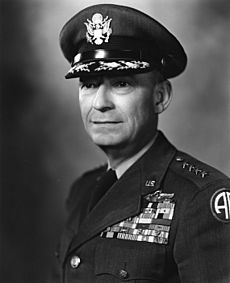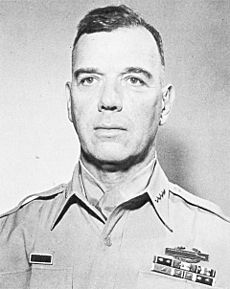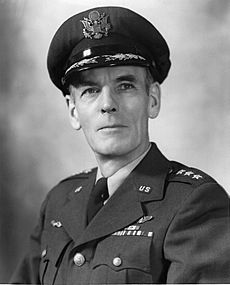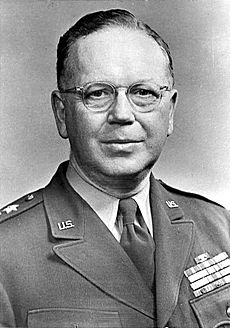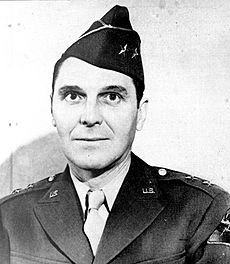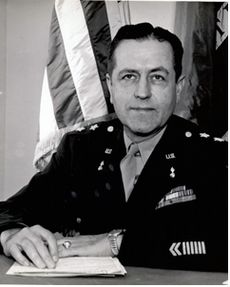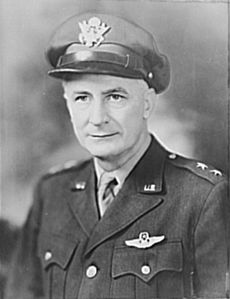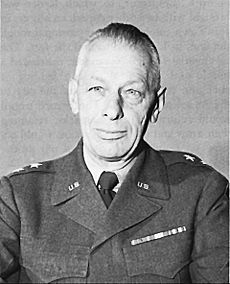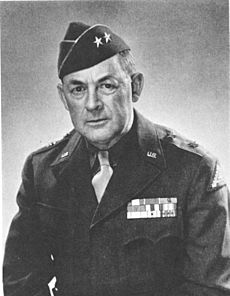The class the stars fell on facts for kids
"The class the stars fell on" is a special name for the group of students who graduated from the United States Military Academy in West Point, New York, in 1915. In the United States Army, generals wear one or more stars as their rank symbol. Out of 164 graduates that year, an amazing 59 (which is 36%) became generals! This was more than any other class in the Academy's history, which is why they got this famous nickname.
Two of these graduates became five-star generals, the highest rank possible. These were Dwight D. Eisenhower and Omar Bradley. Eisenhower later became the 34th President of the United States. Omar Bradley became the first Chairman of the Joint Chiefs of Staff, leading all the military branches. The class also produced two four-star generals, seven three-star generals, 24 two-star generals, and 24 one-star generals.
Interestingly, the name "the class the stars fell on" was used before for the class of 1886. That class also had many generals, including John J. Pershing, who led American forces in World War I. About 32% of that class became generals.
Contents
Meet the Class of 1915
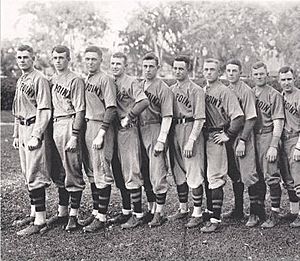
In 1911, 287 new students, called "plebes" (first-year cadets), joined the United States Military Academy. This was the largest group ever at that time. The rules for joining West Point had just changed, allowing more students to be appointed. Fourteen extra cadets, including Omar Bradley, joined six weeks late. They were called "Augustines" because they arrived in August. They missed the tough first training period known as Beast Barracks.
Only 164 cadets managed to graduate on June 12, 1915. Even so, it was still the biggest graduating class up to that point. There were only 105 jobs available for them in the U.S. Army at the time!
The top student leader of the class was Roscoe B. Woodruff. The best 19 graduates all joined the United States Army Corps of Engineers, which builds things for the army. The very top student was William E. R. Covell, who later became a general in World War II.
The youngest graduate was Clyde R. Eisenschmidt, born in 1894. The oldest was Robert B. Lorch, born in 1888. A strong athlete named Thomas B. Larkin was known as the "strong man" of the class. The student with the lowest rank in the class was Charles C. Herrick, known as the class "goat." He later became a successful investment banker and a colonel in World War II.
Luis R. Esteves was the first person from Puerto Rico to attend and graduate from West Point. He was also the first in his class to become a general.
Many students in the class had family who also went to West Point. Sixteen were sons of graduates, and three were even grandsons! For example, Alexander P. Cronkhite was the son of a Major General and the grandson of a Brigadier General. John F. Conklin was the son of a Colonel and the grandson of a Major General.
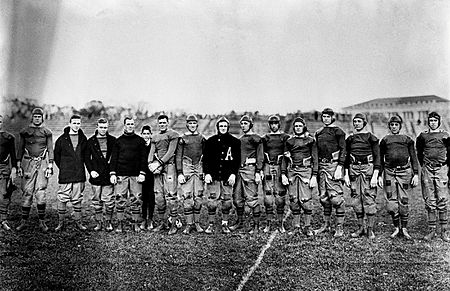
Other students also came from military families:
- Douglas H. Gillette was the son of Major Cassius E. Gillette.
- Stafford LeRoy Irwin was the son of Major General George LeRoy Irwin.
- Sydney Graves was the son of William S. Graves.
- Vernon Evans was the son of Lieutenant Colonel William Pierce Evans.
- John E. Rossell was the son of Colonel William T. Rossell.
- Donald A. Davison was the son of Lorenzo P. Davison.
- Henry McE. Pendleton was the son of Colonel Edwin P. Pendleton.
- Blackburn Hall was the son of William Preble Hall, a Medal of Honor winner.
- Hubert R. Harmon was the son of Colonel Millard F. Harmon Sr.
Hubert Harmon's two older brothers also went to West Point. At first, he was asked to leave because the government didn't want to pay for three brothers from the same family. But his father worked hard to get him readmitted. Both Hubert and his brother Millard F. Harmon, Jr. later became three-star generals.
West Point was originally an engineering school. So, the classes focused a lot on math and technical subjects, not as much on military training. Most military training was about marching and riding horses. Almost all of the top 25 graduates of the class of 1915 joined the Corps of Engineers. The only one who didn't was James A. Lester, who chose to join the artillery instead. He also became a major general.
Military Journeys of the Class
Out of the 164 graduates, 102 (62%) served overseas during World War I. However, only 56 (34%) actually fought in battles. This was pretty normal for army officers back then. Many officers believed that serving overseas would help them get promoted faster, but this wasn't true. Promotions were very slow and based on how long you had served.
For example, Omar Bradley became a first lieutenant in 1916 and a captain in 1917. But then he was made a captain again in 1920 and 1922! He finally became a major for the third time in 1924 and stayed that rank for 12 years. He skipped the rank of colonel completely and became a brigadier general in 1941.
Between World War I and World War II, officers had a good life. They were respected, like upper-middle-class professionals. They usually worked about 30 hours a week, which gave them lots of time for family and sports. They had free healthcare and good salaries. They also lived in nice homes on military bases, in close-knit communities. This steady job was very valuable during the Great Depression (1929-1939), so very few officers quit.
Officers could also attend advanced schools. The Command and General Staff School taught them how to lead large groups of soldiers and how to work as staff. Most officers attended this school. There were also two higher schools: the United States Army War College and the Army Industrial College. These taught about handling even larger military groups and how to organize industries for war.
Some people criticized the army's training. In 1937, General George C. Marshall felt that the schools focused too much on staff work for peacetime, instead of preparing officers for the challenges of leading in wartime. A survey in 1939 found that many officers thought there was too much focus on old skills like horse riding. Even though there were some problems, the training system did create many skilled leaders for World War II.
The first member of the class to become a general was Luis R. Esteves, who was made a brigadier general in Puerto Rico in 1939. During World War II, Dwight D. Eisenhower and Omar Bradley became four-star generals. They made big decisions that affected their classmates' careers. For example, Bradley replaced Major General Roscoe Woodruff, who was supposed to lead the Normandy landings, because Woodruff didn't have experience with beach landings. Woodruff later proved himself in battles in the Philippines.
A sadder story happened to Major General Henry J. F. Miller. He accidentally shared secret information about the D-Day invasion date at a dinner party in 1944. He was sent home and lost his rank, becoming a lieutenant colonel again. Eisenhower wrote to him, saying how difficult it was to judge a friend. Miller retired and was later promoted to brigadier general on the retired list before he passed away.
Besides the generals, another well-known member of the class was Louis A. Merrilat. He was a famous college football player at West Point, playing with Bradley and Eisenhower. He was injured in World War I. Later, he played in the National Football League and became a "soldier of fortune," training armies in Iran and China. He even served in the French Foreign Legion. During World War II, he returned to the U.S. Army and became a colonel.
The last general from the class to pass away was James Van Fleet. He led soldiers in World War II and the Korean War. When he turned 100 in 1992, the Army's Golden Knights parachute team jumped to celebrate! A West Point cadet said, "Everything we want to be, he's already done." Van Fleet died later that year at 100.
The very last surviving member of the class was Edmund De Treville Ellis. He served in World War II and the 1948 Berlin airlift. He retired as a colonel in 1950. He became the oldest living West Point graduate in 1990 and the last member of the class of 1915 when Van Fleet died. He passed away at 104 in 1995. Both he and Van Fleet are buried at Arlington National Cemetery.
Generals of West Point Class of 1915
| Rank | Name | Rank in class | Notes | Ref. |
|---|---|---|---|---|
General of the Army |
Omar N. Bradley | 44 | Led the 82nd Infantry Division (1942), 28th Infantry Division (1942), II Corps (1943), First Army (1944), Twelfth Army Group (1944–1945); became Chief of Staff of the United States Army (1948–1949), and Chairman of the Joint Chiefs of Staff (1949–1953) | |
General of the Army |
Dwight D. Eisenhower | 61 | Supreme Allied Commander in North Africa (1942–1943) and Europe (1942, 1943–1945, 1949–1952); became Chief of Staff of the United States Army (1945–1948), and President of the United States (1953–1961) | |
General |
Joseph T. McNarney | 41 | Deputy Chief of Staff, U.S. Army (1942–1944); Supreme Allied Commander in the Mediterranean Theater of Operations (1944–1945); led U.S. Forces in Europe (1945–1947) | |
General |
James Van Fleet | 92 | Led the 4th Infantry Division, 90th Infantry Division, III Corps in World War II; led the U.S. Eighth Army in the Korean War (1951–1953) | |
Lieutenant General |
Henry Aurand | 20 | Led the 6th Service Command (1942–1944); Deputy Chief Ordnance Officer in Europe (1944); led Normandy Base Section (1944–1945), Services of Supply in China (1945), U.S. Army Pacific (1949) | |
Lieutenant General |
Hubert R. Harmon | 103 | Led the Sixth Air Force (1942–1943, 1946–1947), Thirteenth Air Force (1943–1944); became Superintendent of the United States Air Force Academy (1954–1956) | |
Lieutenant General |
Stafford LeRoy Irwin | 40 | Led the 5th Infantry Division, XII Corps, V Corps, U.S. Forces Austria (1950–1952) | |
Lieutenant General |
Thomas B. Larkin | 21 | Chief of Staff for Services of Supply in the British Isles (1942–1943); led Services of Supply in North Africa (1943), Communications Zone in North Africa (1943–1944), Southern Line of Communications in Europe (1944–1945), 2nd Service Command (1945); became Quartermaster General of the U.S. Army (1946–1949), Deputy Chief of Staff for Logistics (1949–1952) | |
Lieutenant General |
John W. Leonard | 84 | Led the 9th Armored Division (1942–1945), U.S. Army Armor School (1946–1948), V Corps and XVIII Airborne Corps (1951–1953) | |
Lieutenant General |
George E. Stratemeyer | 147 | Led Army Air Forces in China-Burma-India Theater of Operations (1943–1946), Air Defense Command (1946–1948), Continental Air Command (1948–1949), Far East Air Forces (1949–1952) | |
Lieutenant General |
Joseph M. Swing | 38 | Led the 11th Airborne Division (1943–1948), I Corps (1948–1949), Sixth Army (1951–1954) | |
Major General |
John Stewart Bragdon | 5 | Assistant Chief of Military Construction (1945–1949); Deputy Chief of Engineers (1950–1951) | |
Major General |
Ralph P. Cousins | 129 | Led Army Air Force Western Flying Training Command (1942–1946) | |
Major General |
William E. R. Covell | 1 | Director of Fuels and Lubricants (1943–1944); Led Services of Supply in China-Burma-India (1944–1945) | |
Major General |
Luis R. Esteves | 97 | Adjutant General of Puerto Rico (1939–1957) | |
Major General |
Vernon Evans | 55 | Deputy Chief of Staff and Chief of Staff in China-Burma-India (1944–1945) | |
Major General |
Thomas J. Hanley Jr. | 124 | Led Air Service Command in China-Burma-India (1944–1945), Eleventh Air Force (1946–1948) | |
Major General |
Thomas G. Hearn | 106 | Chief of Staff in China-Burma-India (1944); Led Infantry Replacement Training Center (1944–1945) | |
Major General |
Leland S. Hobbs | 46 | Led the 30th Infantry Division (1942–1945), 2nd Armored Division (1946–1947), IX Corps (1949–1950) | |
Major General |
James A. Lester | 23 | Led 24th Division Artillery, XIV Corps Artillery, 24th Infantry Division | |
Major General |
Edwin B. Lyon | 48 | Led VI Bomber Command (1941–1943), Antilles Air Command (1943); Deputy Commander, Army Air Force Flying Training Command (1944–1945); Led Air Forces Mid Pacific (1945–1946) | |
Major General |
Henry J. F. Miller | 110 | Led Air Material Command in Europe (1943–1944). Rank reduced in May 1944 due to a security issue. Retired in November 1944. Promoted to brigadier general on the retired list in 1948. | |
Major General |
Paul J. Mueller | 45 | Led the 81st Infantry Division (1942–1946) | |
Major General |
Vernon Prichard | 134 | Led the 14th Armored Division (1942–1944), 1st Armored Division (1944–1945) | |
Major General |
George J. Richards | 6 | Served on the War Department General Staff (1943–1947) | |
Major General |
Charles W. Ryder | 39 | Led the 34th Infantry Division (1942–1944), IX Corps (1944–1948) | |
Major General |
Henry B. Sayler | 37 | Chief Ordnance Officer in Europe (1942–1945) | |
Major General |
William F. Tompkins | 16 | Served on the War Department General Staff (1943–1945) | |
Major General |
Albert W. Waldron | 32 | Field Artillery Representative for Army Ground Forces (1943–1946) | |
Major General |
Leo A. Walton | 128 | Air Inspector for Army Air Force China Theater (1945–1946); Led Fourteenth Air Force (1946–1948) | |
Major General |
Leroy H. Watson | 151 | Led the 3rd Armored Division (1943–1944), 79th Infantry Division (1945). Also led the International Military Tribunal Command, Southern District of Sixth United States Army, Fort Lewis; Chief of Civil Affairs for U. S. Far East Command; and U.S. Defense Advisory Group, Japan. | |
Major General |
Douglas L. Weart | 10 | Chief of Staff, Caribbean Defense Command (1943–1944); Deputy commander China Theater (1945) | |
Major General |
A. Arnim White | 158 | Chief of Staff, U.S. Seventh Army (1944–1945); Led the 75th Infantry Division and 71st Infantry Division (1945–1946) | |
Major General |
John B. Wogan | 75 | Led the 13th Armored Division (1942–1945) | |
Major General |
Roscoe B. Woodruff | 56 | Led the 77th Infantry Division (1942–1943), VII Corps (1943–1944), 24th Infantry Division (1944–1945), I Corps (1945–1948), XV Corps (1951–1953) | |
Brigadier General |
Herman Beukema | 26 | Director of Army Specialized Training Program | |
Brigadier General |
Carl C. Bank | 53 | Artillery Officer for Allied Forces in North Africa (1942–44); Led 13th Field Artillery Brigade (1944–1945) | |
Brigadier General |
Frederic W. Boye | 150 | Served in China (1944–1945) | |
Brigadier General |
Charles M. Busbee | 31 | Led 102nd Division Artillery (1942–1946) | |
Brigadier General |
John F. Conklin | 13 | Engineer with Third Army (1942–1945) | |
Brigadier General |
John F. Davis | 99 | Chief of Staff 6th Service Command (1942–1944); Director of Information and Education, War Department (1944–1945) | |
Brigadier General |
Michael F. Davis | 96 | Led 78th Flying Training Wing (1944–1945), Army Air Force Central Flying Training Command (1945–1946) | |
Brigadier General |
Donald A. Davison | 19 | Aviation Engineers (1942–1944). Died in Bangalore, India 6 May 1944. Davison Army Airfield is named after him. | |
Brigadier General |
Benjamin G. Ferris | 104 | Deputy Chief of Staff, China-Burma-India Theater (1943–1944) | |
Brigadier General |
Adlai H. Gilkeson | 137 | Led Air Defenses, Panama Canal Zone (1942), III Fighter Command (1944), 312th Fighter Wing (1944–1945) | |
Brigadier General |
Walter W. Hess | 95 | Led 1st Antiaircraft Command (1941–1942), 45th Coast Artillery Brigade (1942), artillery for 36th Infantry Division (1943–1945), Anti-aircraft Replacement Training Center (1944–1945) | |
Brigadier General |
Clinton Wilbur Howard | 30 | Chief of Staff Third Air Force (1941–1942), Army Air Force Technical Training Command (1942–1943), Sacramento Air Service Command (1943–1945) | |
Brigadier General |
Reese M. Howell | 109 | Led 4th, 17th, and 13th Field Artillery Brigades (1940–1944); Assistant Division Commander 82nd Airborne Division (1944); Led 9th Infantry Division Artillery (1944–1946) | |
Brigadier General |
John Keliher | 159 | Deputy Chief of Staff (G-3) U.S. Army Forces Mid Pacific (1942–1944); Deputy Chief of Staff (G-5) U.S. Army Forces Mid Pacific (1944–1945) | |
Brigadier General |
Pearson Menoher | 42 | Chief of Staff XV Corps and Seventh Army (1943–1945); Led 24th Infantry Division in the Korean War (1949–1950) | |
Brigadier General |
Lehman W. Miller | 9 | Chief of Military Mission to Brazil (1940–1942); Led Engineer Replacement Training Center, Fort Belvoir (1942–1944) | |
Brigadier General |
Earl L. Naiden | 68 | Chief of Staff, Ferry Command, China-Burma-India Theater (1942); Chief of Staff Tenth Air Force (1942) | |
Brigadier General |
Hume Peabody | 63 | Commandant Army Air Forces School of Applied Tactics (1942–1944); Led III Tactical Air Command (1942–1944) | |
Brigadier General |
Norman Randolph | 145 | Chief of Staff Second Army (1942–1943); Chief of Staff 3rd Service Command (1943–1944); Led 3rd Service Command (1944–1945) | |
Brigadier General |
John N. Robinson | 120 | Led Fort Richardson (1943–1944); Assistant Division Commander 89th Infantry Division (1944–1945) | |
Brigadier General |
Robert W. Strong | 73 | Chief of Staff, U.S. Army Forces in Africa (1942–1943); Led Cavalry Replacement Training Center (1943–1945); Chief of U.S. Army Mission to Peru (1945–1946) | |
Brigadier General |
Victor V. Taylor | 122 | Served on the War Department General Staff (1941–1943); Munitions Assignment Board (1943–1944) | |
Brigadier General |
Cleson H. Tenney | 77 | Harbor Defense Commander, Central Pacific Area (1942–1943); Led 55th Coast Artillery Regiment (1944); 70th Antiaircraft Artillery Brigade (1945) | |
Brigadier General |
Edward C. Wallington | 82 | Chemical Officer, Third Army (1942–1945); Deputy Chief Chemical Officer (1949–1951) | |
Brigadier General |
Edwin A. Zundel | 29 | Artillery Officer, II Corps (1942), XI Corps (1943–1944), Sixth Army (1944–1945), 41st Infantry Division (1945–1946), Fourth Army (1946–1947) |
See also
 In Spanish: Promoción de 1915 (West Point) para niños
In Spanish: Promoción de 1915 (West Point) para niños


